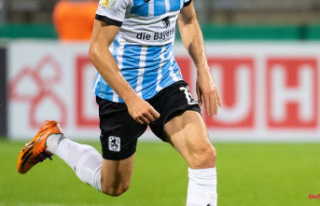The Ford Fiesta is one of the most traditional small car series. But that doesn't protect him from the imminent end. Because on Ford's way to becoming an electric car manufacturer, the Fiesta is now lagging behind: it will only be built until mid-2023. A reminder of one of the most successful cars in Europe.
As a golden bird he is a celebrated Cologne art object, as a chic city runabout a successful woman understander and as a powerful athlete he enjoys cult status. Now the career of one of the most successful small cars in the world is coming to an end: in the summer of 2023, Ford will stop producing the Fiesta after 47 years of construction. A look back at its eventful history.
For the experts, the Ford Fiesta came much too late. After all, when production of the city car developed in Cologne started on May 11, 1976, all lanes of the small class seemed to be occupied. No fewer than 30 European competitors were already fighting for the favor of small car buyers. However, Europe wasn't enough for the Fiesta. It would be the first short-format Ford to be sold on every continent - even in North America.
After all, the Fiesta was the most important new development since the legendary Model T of 1908, as Ford Cologne boss Bob Lutz announced at the premiere. Which is why CEO Henry Ford II - just a short time before that a staunch critic of small cars - insisted on personally coming to the Rhine for a test drive. A test drive, which he concluded with the praise of "good job".
The small car fans apparently found Ford's verdict understated. In any case, they sent the Fiesta, which was inspired by the Italian design studio Ghia and finalized by Ford designer Uwe Bahnsen, on an unprecedented flight that – according to German counting – should carry it over eight vehicle generations. First, the lightning-fast Ford caught up with the VW Golf in the mid-1970s when it joined the production millionaires' club after just 31 months, then it became the benchmark for all small cars. A total of 18.2 million copies were delivered worldwide in just under half a century.
Finding a name for Ford's little one, which initially haunted the media under the name "Bobcat" (bobcat), remained exciting almost to the last moment. However, a compact Mercury had already been named after the lynx, so Henry Ford II was looking for other name ideas. For him, the christening of every new vehicle model was a matter for the boss. As he explained later, he came across the alliteration Ford and Fiesta, which he thought was a perfect combination. Especially since the new Ford should also be manufactured in a specially built plant in Valencia, Spain.
The only problem: the rights for Fiesta were with arch-rival General Motors (GM). A quick phone call to GM President Tom Murphy solved the problem. Perhaps Murphy would have been less accommodating with the name release had he known he was becoming the godfather of the future king of small cars.
Whether built in Valencia for southern Europe, in Dagenham for the British or in Saarlouis and Cologne for a further 70 markets, the little one became an ongoing fiesta for Ford. Exports to the USA alone did not bring in the hoped-for harvest, although the US media advertised the Ford praised as the best imported small car: a "miracle car built in Germany" for the "San Diego Freeway" as well as for the "high-speed autobahn". It was no use, in 1977 the first oil crisis had already been overcome and so the savings champion positioned against VW Rabbit (Golf) and Honda Civic had no chance in the land of road cruisers. Fiesta from Mexican production, which are also offered as a classic sedan, have only been more successful there since 2010.
In Germany, on the other hand, the start could not have been better, as Ford experienced its best result of all time there thanks to the Fiesta in 1977. The Cologne Fiesta main plant, which started in 1979, is considered by industry circles to be one of the best-utilized factories in the world with an export quota of 80 percent. Finally, the artistic culmination of the career of the world car is unique: in 1991, performance artist HA Schult designed a Fiesta as a golden bird with mighty eagle wings, which found its eyrie on the roof of the Cologne City Museum.
The Fiesta was originally only supposed to be a stylish small car, which rounded off the model range as the first Ford with front-wheel drive, a transverse engine and a tailgate. For this mission, the then second-largest automotive company in the world invested a total of around two billion marks, the largest single budget that Ford had previously spent. Money well spent, as the Fiesta became a champion that set wildly different bests.
Not only with sales records, but also on a unique 300,000-kilometer high-speed drive, with motorsport milestones such as the first racing series exclusively for women, with the highest proportion of women among small car buyers or as a Spanish people's car that pushed Seat from the top. The construction of the plant in Valencia also paid off and led to most European mass brands following suit and setting up factories in Spain, which was then the low-wage country.
The Fiesta challenged these competitors with advertising slogans such as "la concurrente" (the competitor) in France, "una forte rivale" (a strong rival) in Italy and "Sometimes a champion falls from the sky" in Germany. But also as a noble mini with fine Ghia equipment. There were also creative concept cars such as the Fiesta Corrida and Prima prototypes designed by Ford subsidiary Ghia in 1976.
The Corrida surprised as a gullwing coupé and the Prima as a convertible pick-up with rear attachments for platform trucks, coupés, fastbacks and station wagons. The Ghia Tuareg from 1978 as a crossover pioneer and the Ghia Bebob from 1990 as a lifestyle pick-up were also stars of the fair. Cabriolet designs based on the Tropic study from 1980 even went into small series. However, sports versions for the GTI fraction were even more popular.
Around 1981 the Fiesta XR2 with 62 kW/84 hp. "Get in the starting position for the power play," the Ford advertisement called for, because the XR2, with a sprint value of ten seconds for passing the 100 km/h mark, beat almost all competitors from the Fiat 127 Sport to the VW Polo GT the places. The Fiesta had a truly unique position for a short time with a 40 kW/54 hp diesel engine, which made the Ford the smallest German economy champion with a compression-ignition engine in 1983.
The first Fiesta generation rolled off the assembly line almost five million times, a look modified in September 1983 was enough to keep the three-door fresh. It was only after 13 years that a new design became necessary, which was available in a larger format and also as a five-door model. Like its predecessor, this Fiesta, which was offered until 2002, shone with the best space in its class. Incidentally, at times in parallel as the Mazda 121, the temporary integration of the groups made this possible.
The Fiesta started a real family in 1996: First came the even smaller Ka, a year later the sports coupé Puma and in 2002 the Roadster Streetka and the high-roof combination Fusion followed, in 2012 the mini-van B-Max.
However, the versatile Fiesta only achieved cult status in the sports version ST, which is also available in the current generation launched in 2017. It too is likely to shed a tear or two: The ST, which is priced comparatively civilly, once again significantly tightened the high driving dynamics of the standard model and is considered perhaps the most dynamic small car athlete on the market.
For Ford, the Fiesta farewell is a turning point. The brand intends to focus on e-mobiles and higher-quality vehicles in the future. The entry-level model from 2023 will be the mini crossover Puma, which is closely related to the Fiesta and will also be available in an E version from 2024. As early as 2023, a compact electric crossover is scheduled to start at the main plant in Cologne, which will form the core model of the brand in the future. Against this background, the discontinuation of Fiesta production comes as no surprise.
The change to the e-car provider is not the only reason for the end of the Fiesta: Most recently, new registrations in Germany and Europe had fallen by double-digit rates.












